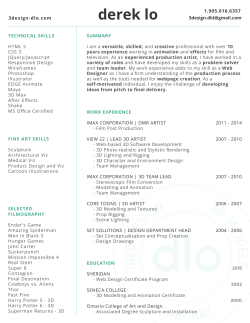
CSCI 520 Computer Animation and Simulation 1
CSCI 520
Computer Animation
and Simulation
1
Computer Animation
and Simulation
2
About the teacher
• Assistant professor in CS
• Post-doc at MIT (2 years)
• PhD, Carnegie Mellon University
• jnb@usc.edu
3
About the teacher
• Background:
BSc Mathematics
PhD Computer Science
• Research interests:
graphics, animation, real-time physics,
control, sound, haptics
4
Teaching Assistant
• Yijing Li
• Tuesday, 1:00-3:00pm
• SAL 235
5
Who is the course for
• PhD students
• MSc students
• Advanced undergraduates
• CS 580 background will be
very helpful !!
6
Why take this course
• Opens the door to jobs in
computer graphics
• Make better games
• Put math and physics to use in the
real world
• Real-time graphics is cool
• Impress your friends with demos
7
Prerequisites
• A grade of at least B in CS480 or CS580,
or explicit permission of instructor
• Familiarity with calculus, linear algebra and
numerical computation
• C/C++ programming skills
• See me if you are missing any and
we haven’t discussed it
8
Recommended Textbooks
• Rick Parent: Computer Animation,
Second Edition: Algorithms and Techniques
• OpenGL Programming Guide (“Red Book”)
Basic version also available on-line (see Resources)
9
Evaluation
• Assignments: 3 x 21%
• Final Exam: 37%
10
Academic integrity
• No collaboration!
• Do not copy any parts of any of the
assignments from anyone
• Do not look at other students' code,
papers, assignments or exams
• USC Office of Student Judicial Affairs
and Community Standards will be notified
11
Assignment Policies
• Programming assignments
- Hand in via Blackboard by end of due date
- Functionality and features
- Style and documentation
- Artistic impression
• 3 late days, usable any time during semester
• Academic integrity policy applied rigorously
12
Class goals
• Gain ability to create animations
and 3D simulations
• Learn a 3D graphics API
(or improve skills)
• Improve code optimization skills
13
Applications
• Virtual reality
• Interactive computer animation
• Surgical simulation; preoperative
planning
• Computational robotics;
manipulation
• Video games
• Assembly planning
• Scientific visualization
• Education
• E-commerce
14
Keyframe Animation
15
Motion Capture
16
Inverse Kinematics
www.learnartificialneuralnetworks.com
source: Autodesk
17
Character Rigging
18
Facial Animation
19
Crowd Animation
20
Crowd Animation
21
Maya
22
Fluids
Source:
Stanford University
23
Deformations
Source:
CMU
24
Cloth
Source:
ACM SIGGRAPH
25
Simulating Large Models
Source:
Cornell University
26
Simulating Large Models
27
Sound
Source:
CMU
28
Self-collision detection
Source:
USC
29
GPU programming
• Vertex shader
• Fragment shader
• CUDA
• OpenCL
30
Physics in games
Source:
Symposium on
computer animation
31
Force-feedback Rendering
32
Haptic Interfaces
• hap·tic ('hap-tik)
adj.
Of or relating to the sense
of touch; tactile.
33
Surgical Simulation
Source:
Cornell University
34
Multibody dynamics
35
TOPICS TO BE COVERED:
• Overview of computer animation
• Primer on numerical linear algebra
• Dynamical systems, numerical integration of ODEs
• Constraints and contact
• Character Rigging
• Inverse Kinematics
• Maya
• Crowds
• Rigid body dynamics
• Collision detection
• Structured deformable objects (solids, cloth, hair)
• Fracture and cutting
• Fluids (Navier-Stokes)
• Haptics
• Sound simulation (acoustics)
• Programmable graphics hardware (GPUs)
• Case study: Havok engine for physics in games
• Motion capture
36
CSCI 520
Computer Animation
and Simulation
http://www.jernejbarbic.com
37
© Copyright 2025





















